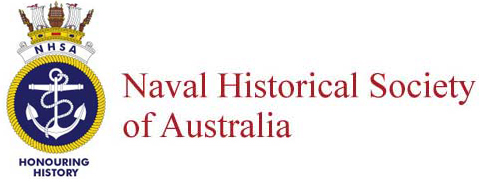- Author
- Letter Writer
- Subjects
- Ship design and development, Letter to the Editor
- Tags
-
- RAN Ships
- None noted.
- Publication
- March 2018 edition of the Naval Historical Review (all rights reserved)
The picture of the commissioning of HMAS Hobart on the front cover of the December 2017 edition of the Naval Historical Review – particularly that of the red kangaroo symbol affixed to the superstructure – has prompted me to write with a possible explanation of how and when this symbol originated.
Early in 1958, and just prior to a nine month tour of duty with the Far East Strategic Reserve, a Leading Signalman in HMAS Voyager took an Australian penny over to a workshop on Garden Island Dockyard in Sydney and asked his contacts there if a template of a kangaroo could be cut based on the design on the coin.
At that time HMA Ships at sea flew the British White Ensign and carried no other symbols which identified them as Australian. To rectify this – particularly when carrying out RAS with United Navy vessels – the Leading Signalman came up with the idea (supported I believe by the Yeoman of Signals) that a discrete red kangaroo be painted on the back of the 10 inch signal lamps on both sides of the flag deck. These lamps could then be turned around during RAS with our American cousins to show the jumping marsupial – so declaring, to all who saw it, that we were Australians.
It worked a treat and Voyager found within a short time other HMA Ships adopted the practice – some even wanting to borrow our template to paint the back of their signal lamps. When later asked what prompted him to think of this the Leading Signalman, a WW11 veteran (like many of the senior ratings at the time) said: “He wanted to make sure the first Australian Daring class destroyer to be allotted duty in the FESR carried something that clearly identified her as Australian and the kangaroo design on the penny fitted the bill.”
I played a very modest part in all of this because at the time I was an Ordinary Signalman serving in my first sea draft and, along with other duties assigned, mostly of a manual nature, I was responsible for drawing the paint from the ship’s paint locker and painting the kangaroos!
Gavin Ryan – Perth, WA
By Editor: In checking our archives our archives the Journal of the Australian Naval Institute Headmarkdated December 2013 contains a story on the First Red Roo. In summary this says in the 1950s the RAN converted four of its five Q-class destroyers to Type 15 fast anti-submarine frigates. HMAS Queenboroughcompleted her conversion in 1954 and the following year undertook a global circumnavigation.
While in British waters she operated with an RN squadron which used the Red Hand of Ulster as a funnel emblem. To retain a visible Australian identity, Queenboroughalso displayed her own red kangaroo. This remains the first known use of the red kangaroo on the funnel of an HMA Ship. By the 1980s the insignia had been adopted across the RAN’s major surface fleet.

Looking back even further a photograph is found in the AWM collection (078677) of Able Seaman John Conway keeping watch aboard ML 802 during amphibious operations off New Guinea dated 28 January 1945. Fairmiles were known for their harsh living conditions which resulted in a degree of latitude being given to the dress and appearance of both men and boats. In this instance in the background a solid kangaroo motif (colour unknown) is attached to the vessel. The mystery continues.
